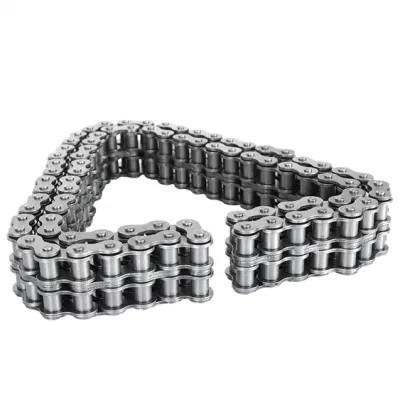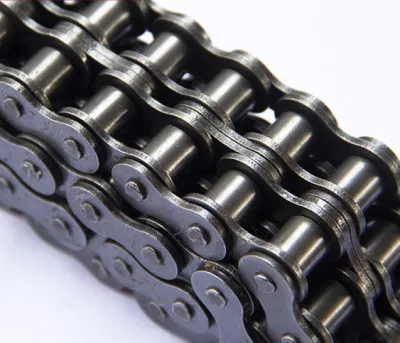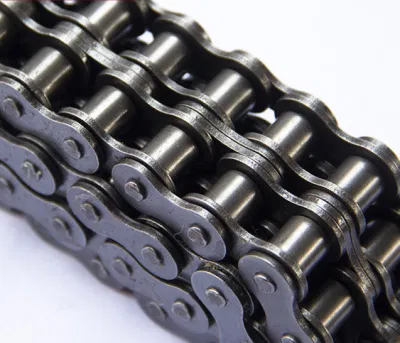Product Description
| Chain No. | Pitch
P |
Roller diameter
d1max |
Width between inner plates b1min mm |
Pin diameter
d2max |
Pin length | Inner plate depth
h2 max |
Plate thickness
t/Tmax |
Breaking load
Q |
Weight per meter q kg/m |
||||||||
| Lmax mm |
Lcmax mm |
||||||||||||||||
| 16BSS-1 | 25.4-0-0. p. 211. Retrieved 17 May 2-0-0. p. 86. Retrieved 30 January 2015. Green 1996, pp. 2337-2361 “ANSI G7 Standard Roller Chain – Tsubaki Europe”. Tsubaki Europe. Tsubakimoto Europe B.V. Retrieved 18 June 2. External links Wikimedia Commons has media related to Roller chains. The Complete Xihu (West Lake) Dis. to Chain Categories: Chain drivesMechanical power transmissionMechanical power control More Products
Company Workshop
Company Certificates Q. what is your payment term? Q:Can we print our logo on your products? Q: Can you make chains according to my CAD drawings?
What are the benefits of using a corrosion-resistant bush chain?A corrosion-resistant bush chain offers several advantages in various applications where exposure to moisture, chemicals, or other corrosive elements is a concern. Here are the key benefits: 1. Extended service life: Corrosion-resistant bush chains are specifically designed to withstand corrosive environments, resulting in a longer service life compared to standard chains. They are resistant to rust, oxidation, and other forms of corrosion, minimizing the risk of premature failure. 2. Reliable performance: By utilizing corrosion-resistant materials, the bush chain maintains its structural integrity and mechanical properties even in corrosive conditions. This ensures reliable and consistent performance over an extended period. 3. Reduced maintenance and downtime: Corrosion-resistant bush chains require less maintenance compared to standard chains. They are less susceptible to damage and wear caused by corrosion, reducing the frequency of lubrication, inspection, and replacement. This results in lower maintenance costs and less downtime for the equipment. 4. Improved safety: Corrosion can weaken a chain, compromising its strength and integrity. By using a corrosion-resistant bush chain, the risk of chain failure and potential accidents is significantly reduced, enhancing workplace safety. 5. Versatility in harsh environments: Corrosion-resistant bush chains can be used in a wide range of applications and industries where exposure to moisture, chemicals, saltwater, or other corrosive agents is prevalent. They are commonly employed in marine environments, chemical processing plants, wastewater treatment facilities, food processing plants, and outdoor equipment. 6. Cost-effective solution: While corrosion-resistant bush chains may have a higher initial cost compared to standard chains, their extended lifespan and reduced maintenance requirements result in long-term cost savings. The lower frequency of chain replacement, repairs, and associated downtime contributes to overall cost-effectiveness. It is important to select the appropriate corrosion-resistant bush chain based on the specific corrosive agents and environmental conditions it will be exposed to. Consulting with chain manufacturers or industry experts can help in choosing the right chain material and coating for optimal corrosion resistance.
What are the common signs of wear and tear in a bush chain?As a bush chain is subjected to regular use and stress, it can exhibit signs of wear and tear over time. Here are some common indicators to look out for: 1. Chain Elongation: One of the most apparent signs of wear in a bush chain is elongation. This occurs when the chain’s pitch increases due to the stretching of the bushings, resulting in a loose and elongated chain. Elongation can lead to improper engagement with the sprockets and affect the overall performance of the chain. 2. Pin and Bushing Wear: The pins and bushings of a bush chain experience friction and wear during operation. Excessive wear can be observed as grooves or significant flattening of the pin surfaces or bushing bores. This wear can lead to increased clearances, reduced chain strength, and compromised performance. 3. Plate Wear: The inner and outer plates of a bush chain can also exhibit signs of wear. This can include visible signs of erosion, thinning of the plates, or rough surfaces. Plate wear can affect the chain’s overall strength and increase the risk of failure. 4. Sprocket Wear: Wear on the teeth of the sprockets is another indication of chain wear. Excessive wear can result in irregular tooth profiles, tooth tip thinning, or significant tooth wear. Sprocket wear can lead to poor chain engagement, increased noise, and reduced efficiency. 5. Misalignment: Misalignment of the chain can cause uneven wear on the pins, bushings, and plates. Signs of misalignment include uneven wear patterns, abnormal noise during operation, and premature failure of the chain components. 6. Increased Noise and Vibration: Excessive wear in a bush chain can result in increased noise and vibration during operation. Unusual rattling, clanking, or grinding sounds may indicate worn-out components or poor chain engagement. Regular inspection of the chain and being attentive to these signs of wear and tear is crucial. When any of these signs are noticed, it is recommended to take appropriate measures such as replacing the chain or repairing the worn components to ensure the safe and efficient operation of the equipment.
How do you select the right bush chain for your application?Choosing the right bush chain for your application is essential to ensure optimal performance and longevity. Here are some factors to consider when selecting a bush chain: 1. Load Capacity: Evaluate the maximum load that the chain will need to transmit. Consider factors such as weight, acceleration, and shock loads. Choose a bush chain with a load capacity that exceeds the anticipated load to ensure reliable operation. 2. Speed: Determine the operating speed of the chain. Higher speeds may require chains with specialized designs to minimize wear, reduce friction, and maintain accurate timing. 3. Environmental Conditions: Assess the environmental conditions in which the chain will operate. Consider factors such as temperature, humidity, dust, chemicals, and exposure to corrosive substances. Select a bush chain that is designed to withstand the specific conditions of your application. 4. Size and Configuration: Determine the required chain size based on the available space and the dimensions of the sprockets or pulleys. Consider the pitch, width, and overall dimensions of the chain. Additionally, assess whether a standard or custom configuration is needed to meet the application requirements. 5. Lubrication Requirements: Determine the lubrication method and frequency required for the chain. Some bush chains are self-lubricating, while others may require regular lubrication. Consider the availability of lubrication systems and the maintenance requirements of the chain. 6. Reliability and Durability: Assess the expected operational lifespan and the reliability requirements of your application. Look for bush chains from reputable manufacturers known for producing high-quality, durable products. Consider factors such as wear resistance, fatigue strength, and overall reliability. 7. Cost: Evaluate the cost-effectiveness of the bush chain, considering both the initial investment and long-term maintenance costs. Balance the performance requirements with the available budget. Consult with a knowledgeable supplier or engineer to ensure you select the right bush chain that meets your specific application requirements. They can provide guidance based on their expertise and help you choose a chain that offers optimal performance and durability.
| ||||||||||||||||





